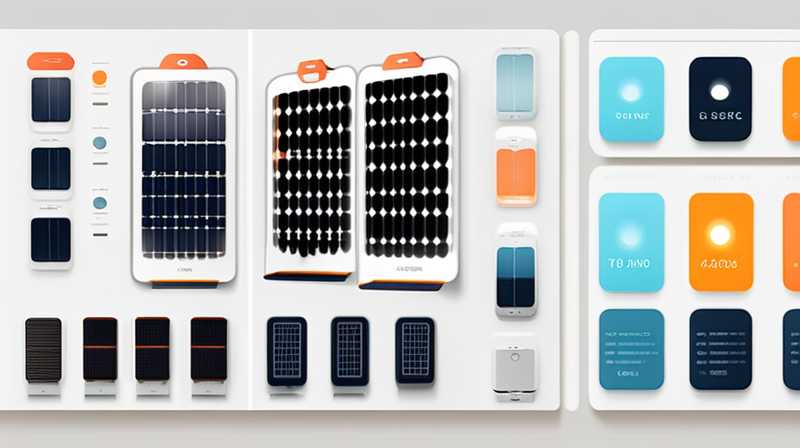
1. Aiming for an efficient solar charging system, the optimal range of milliamps (mA) largely depends on various factors such as the battery capacity, panel output, and device requirements. Here are relevant considerations: 2. The ideal current for charging typically lies between 500 mA to 2000 mA, depending on the values of the aforementioned factors. 3. Battery types play a significant role; lead-acid batteries have different requirements compared to lithium-ion batteries. 4. System design should factor in panel efficiency, solar irradiance, and necessary loss compensation.
1. UNDERSTANDING SOLAR CHARGING
Solar charging fundamentally involves converting sunlight into electrical energy using solar panels. The efficiency of this process greatly hinges on various variables such as panel type, geographical location, and seasonal changes. First, solar panels operate optimally under direct sunlight, with output fluctuating due to cloud cover, ambient temperature, and time of day.
When assessing the current output, it is essential to recognize that every solar panel has a specific output measured in watts. This output translates differently in terms of milliamps (mA) depending on the voltage and system design employed. Typically, a solar panel rated at 20 watts at 18 volts will produce about 1,100 mA under ideal conditions. Such understanding assures users of the feasibility of charging devices or batteries adequately.
2. DETERMINING THE NEED FOR AMPERAGE
Recognizing the device or battery needing charge is critical in determining the necessary mA for solar charging. For instance, standard USB-powered devices require around 500 mA for regular operation, whereas tablets and power-hungry devices may need up to 2,000 mA. Assessing the device specifications offers insights into how much current is suitable. Matching the amperage needs is a pivotal step to avoid any operational inefficiencies.
Furthermore, different battery types possess distinct charging characteristics. Lead-acid batteries, widely used in many applications, generally require a steady current of around 10-20% of their total amp-hour rating for the most efficient charging. In contrast, lithium-ion batteries often demand a current that comprises 0.5C to 1C, meaning that a battery with a 2,000 mAh capacity would require 1,000 to 2,000 mA for optimal charging. Evaluating the battery type ensures efficiency and longevity of the storage medium.
3. PANEL AND SYSTEM DESIGN
Analyzing solar panel output is indispensable in creating an efficient solar charging system. Solar panels generate outputs depending on sunlight exposure and the quality of the panel construction. Higher-quality multijunction panels can yield more consistent and higher outputs compared to crystalline silicon panels under varying sunlight conditions.
The configuration of the system should also be considered, including connections and battery management systems. Series connections increase voltage while parallel connections boost amperage. Arranging the panels in the appropriate configuration enhances overall output and aligns with current requirements efficiently. Ensuring compatibility with existing systems or devices is vital to avoid damaging components or inefficient charging.
4. EFFICIENCY OVER TIME
Solar charging systems generally experience efficiency loss because of shading, temperature fluctuations, and other environmental factors. These aspects underscore the relevance of monitoring systemic performance regularly. Employing a charge controller can optimize performance by regulating the voltage and current flow to batteries, which is especially vital for preventing overcharging.
Moreover, continuous advancements in technology are paving the way for more refined systems. Smart chargers now exist that can adapt output based on ambient conditions. Such technologies ensure that even in less-than-ideal scenarios, solar charging remains viable.
5. OTHER FACTORS AT PLAY
Beyond the primary consideration of milliamps, several additional elements affect solar charging efficiency. The geographical location of the solar array significantly influences performance; regions closer to the equator typically receive more direct sunlight, augmenting daily output.
Seasonal variations impact solar charging too; for instance, winter months often see reduced sunlight hours and increased cloud cover. Planning for these seasonal variations involves assessing historical weather data to determine expected performance and adapting systems accordingly.
FAQs
WHAT IS THE IDEAL CURRENT OUTPUT FOR SOLAR CHARGERS?
Typically, for handheld devices, currents ranging from 500 mA to 1 A are appropriate, while larger devices may require around 2 A or higher. Nonetheless, this can vary based on the specific demands of the device and its battery type.
HOW DOES BATTERY TYPE INFLUENCE CHARGING CURRENT?
Different battery chemistries have distinct charging requirements. Lead-acid batteries charge slowly and often require a considerably lower current compared to lithium-ion batteries, which can accept higher currents without damage, making them more adaptable for solar systems.
DOES ENVIRONMENT AFFECT SOLAR CHARGING EFFICIENCY?
Yes, environmental factors such as temperature, geographical location, and weather conditions play significant roles in charging efficiency. Periods of low sunlight can lead to lower output, thus necessitating larger panels or multiple panels for consistent charging.
Conclusion
In summary, selecting the appropriate milliamps for solar charging requires nuanced consideration of various interdependent factors. Factors such as battery type, device power needs, environmental influences, and panel efficiency play critical roles in determining the optimal charging current. Careful evaluation guides individuals in balancing efficiency with operational needs, ensuring longevity and functionality of both devices and batteries.
Understanding the nuances of solar charging is imperative for both end-users and industry professionals. A well-structured system that accommodates the needs of devices and batteries while factoring in environmental considerations leads to maximized performance. Searches for solar charging solutions thus culminate in thorough research and experimentation; these elements are equally paramount in realizing the benefits of solar energy.
Integrating diverse solar charging applications means taking a granular approach to analyzing amp requirements; consequently, informed adjustments align with energy and device requirements while adapting to changing conditions. The evolution of solar technology continues to present new opportunities, ensuring robust, efficient systems for present and future applications.
Original article by NenPower, If reposted, please credit the source: https://nenpower.com/blog/how-many-milliamps-are-suitable-for-solar-charging/


